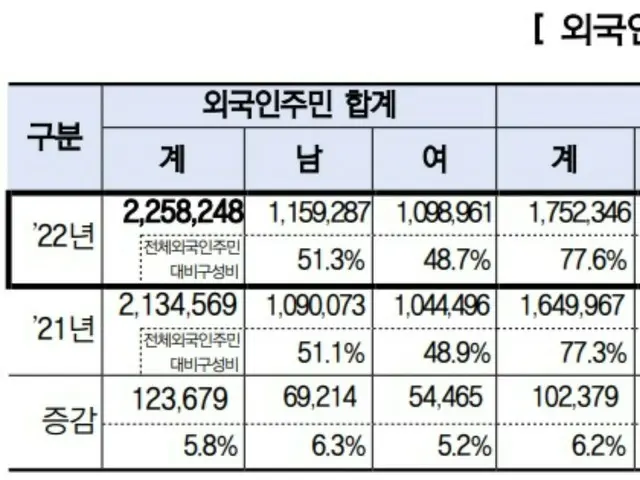This is an increase of 23,679 people (5.8%). The proportion of the total population also reached a record high of 4.4%. The South Korean Ministry of Administration and Security announced this on the 8th.
The ministry analyzed the National Statistics Agency's comprehensive population and housing survey data and announced the 2022 Current Status of Foreign Residents in Local Governments.
According to the Ministry of Health, Labor and Welfare, the number of foreign residents decreased in 2020 and 2021 when entry restrictions were imposed due to the spread of the COVID-19 virus, but began to recover as the coronavirus pandemic began to subside. international students and foreigners
This is due to the large increase in the number of people with similar nationalities. The number increased by 32,709 (20.9%) and 29,000 (7.9%), respectively.
By type, there were 1,752,346 people who did not have Korean nationality, and 1,752,346 people who had acquired Korean nationality.
There were 223,825 people. The number of children of foreign residents born in South Korea is 282,077. Among those who do not have Korean nationality, there were 189,397 international students, and marriage immigrants (1
(75,756 people) for the first time. This is likely due to South Korean universities focusing on attracting foreign students as the school-age population declines. Also, K culture (
The global boom in Korean culture (Hallyu culture) is also increasing interest in South Korea. The number of compatriots with foreign nationality has reached 397,581 and is steadily increasing. The number of foreign workers increased by 7,964 (2%) to 400,031.
There were 39 people, and 586,473 other foreigners, including illegal immigrants. By region, the number of foreign residents increased in all 17 cities and prefectures nationwide. Gyeonggi-do increased by 37,010 people.
It was the highest number of people at 751,507. The increasing trend was also noticeable in Seoul (up 15,546 people) and Incheon (up 12,171).
By city/gun/city, Ansan city (101,850 people), Suwon city (68,633 people), and Siheung city (60,84 people).
The top five regions all belonged to Gyeonggi Province: 82 people), Hwaseong City (66,955 people), and Bucheon City (55,383 people).
"Foreign residents with 10,000 or more foreign residents or 5% or more of the total population"
There were 97 "concentrated residential areas", an increase of 11 locations from the previous year. By city/province, Gyeonggi-do recorded the highest number of cases with 23, followed by Seoul with 17, Gyeongsangbuk-do and Gyeongsangnam-do with 9 each, and Chungcheongnam-do with 8.
.
2023/11/09 05:36 KST
Copyrights(C) Herald wowkorea.jp 104

